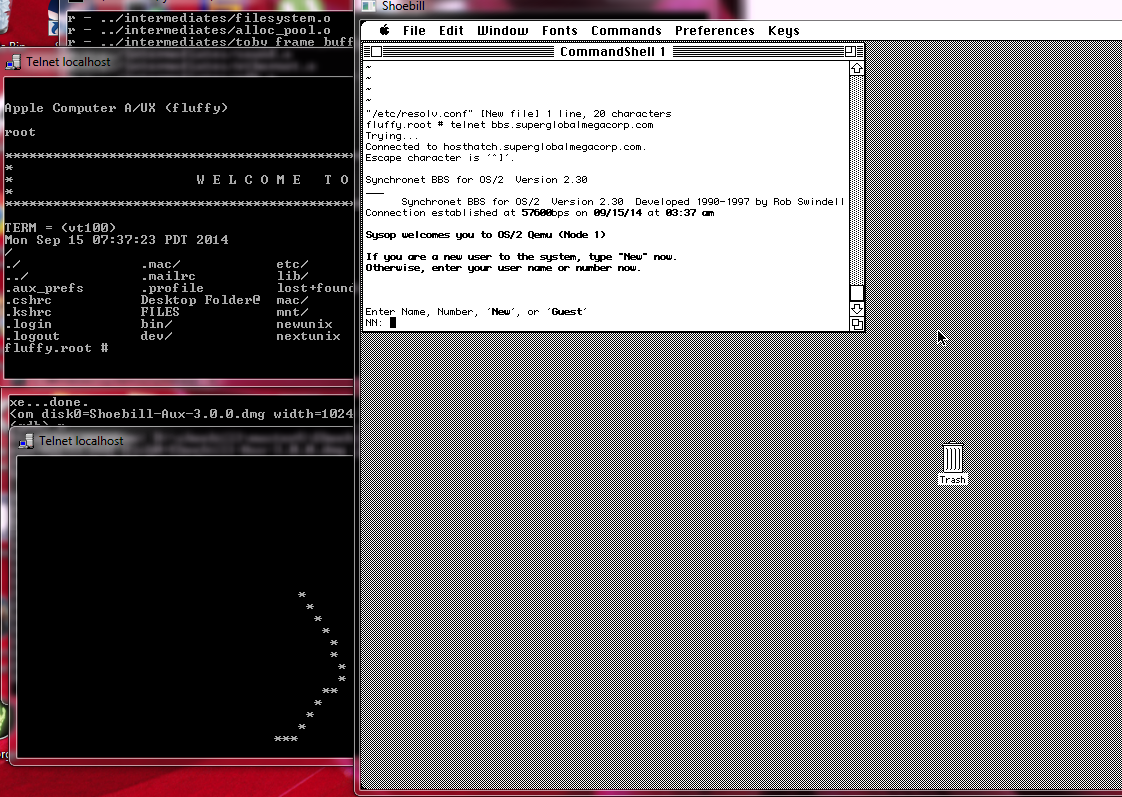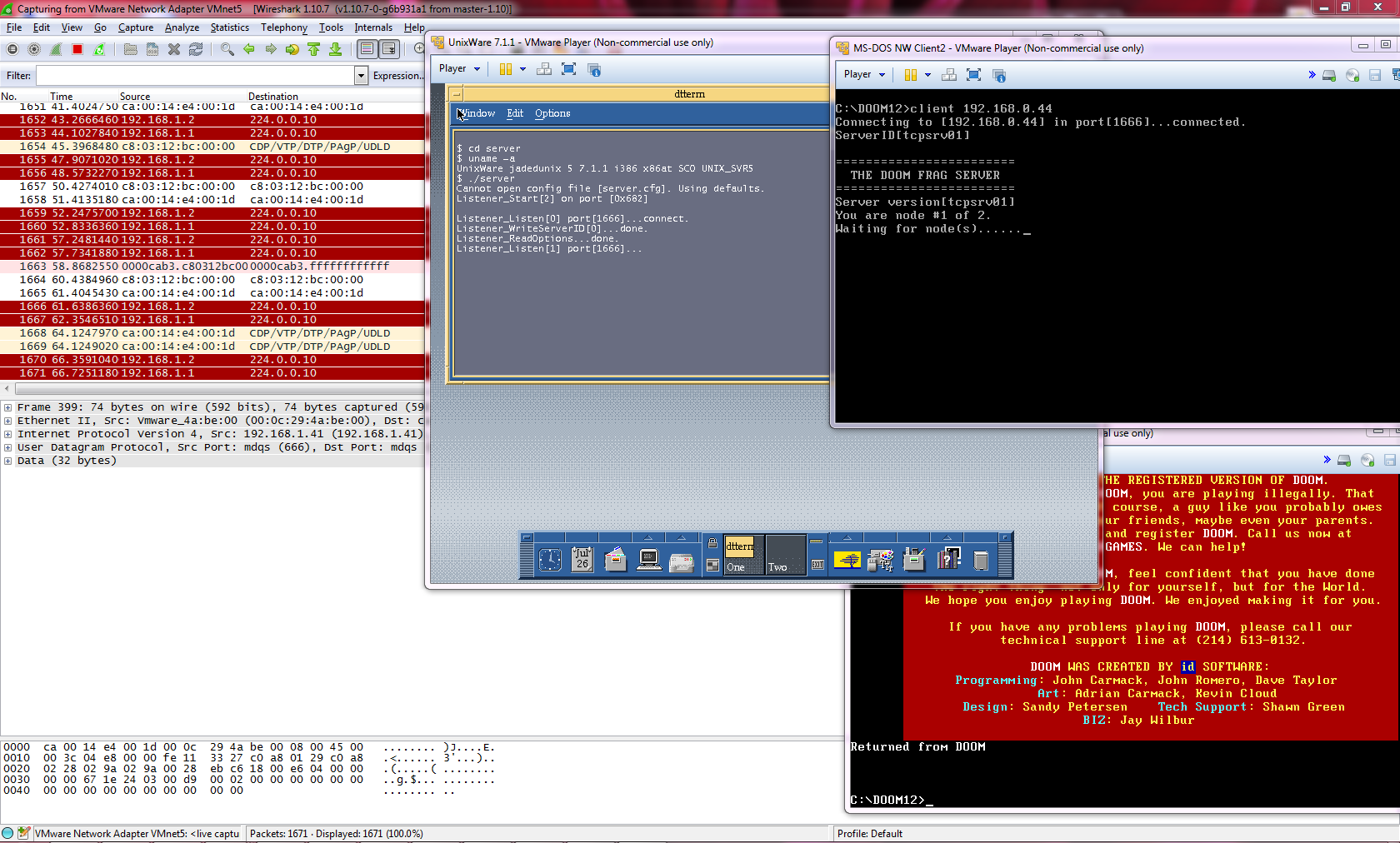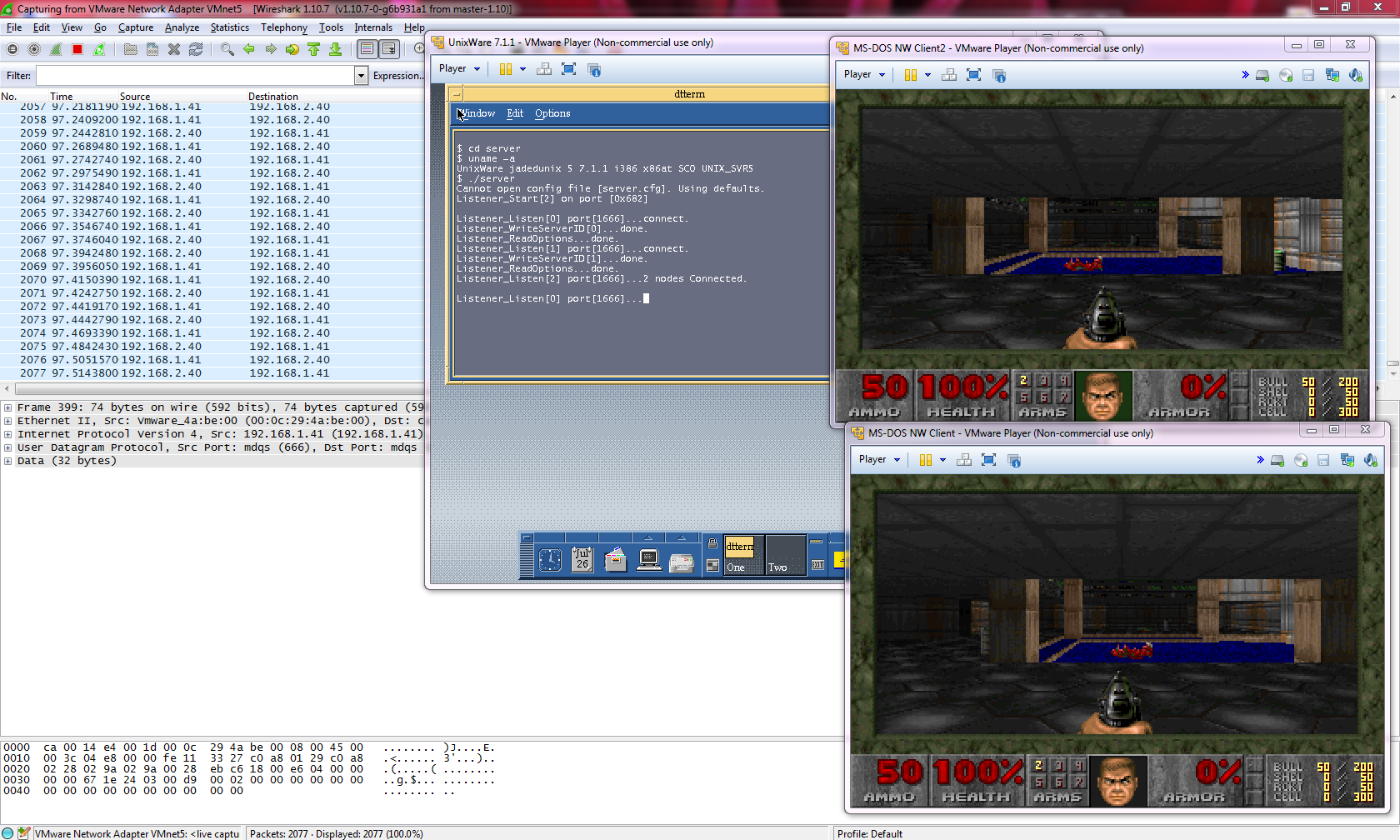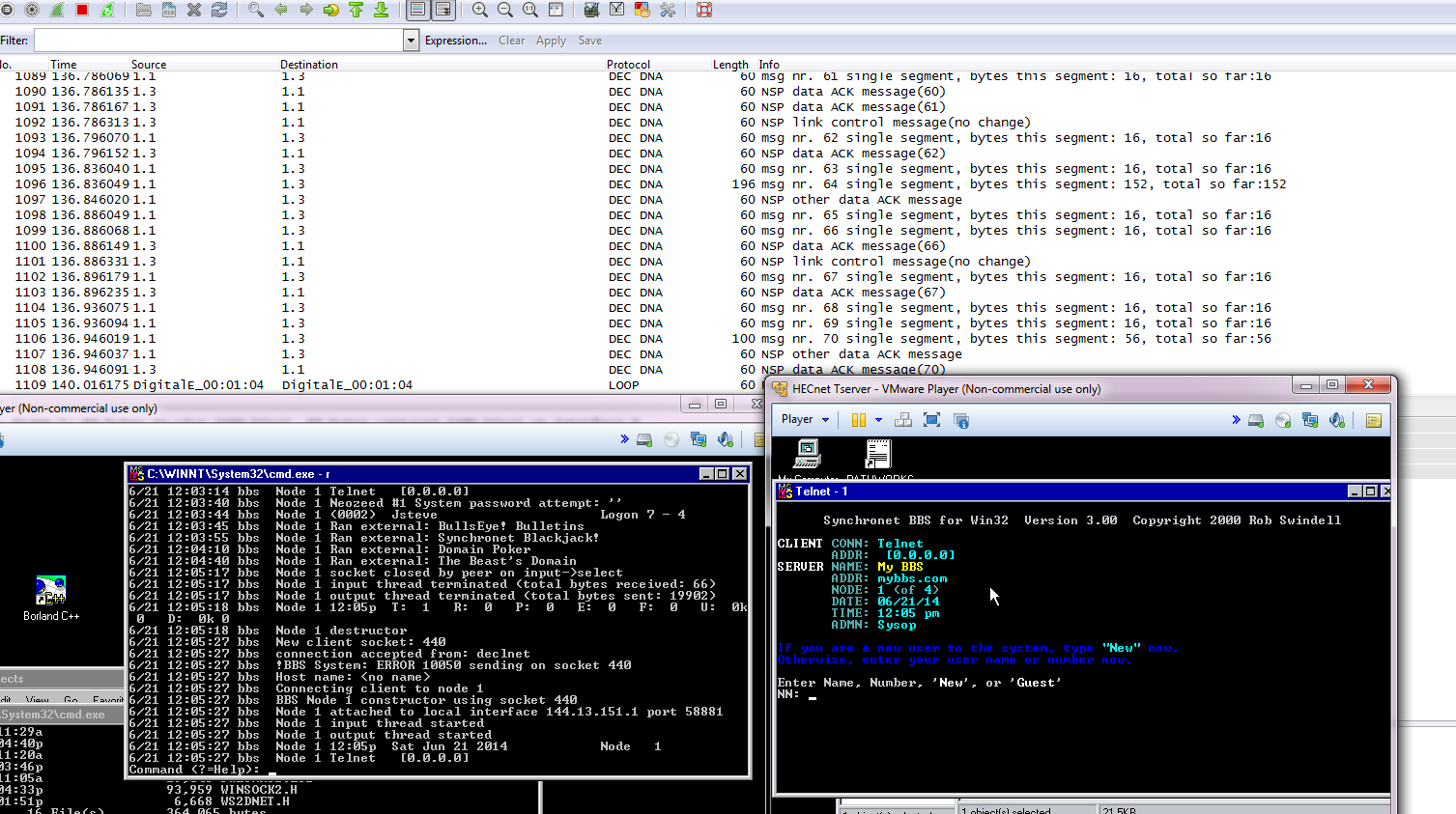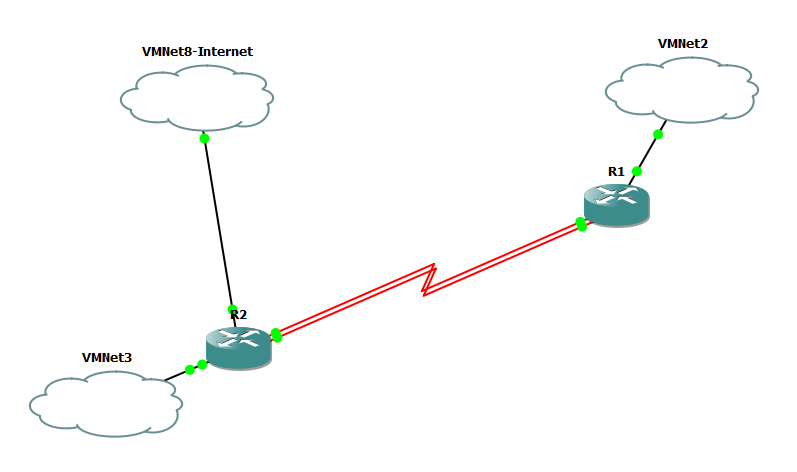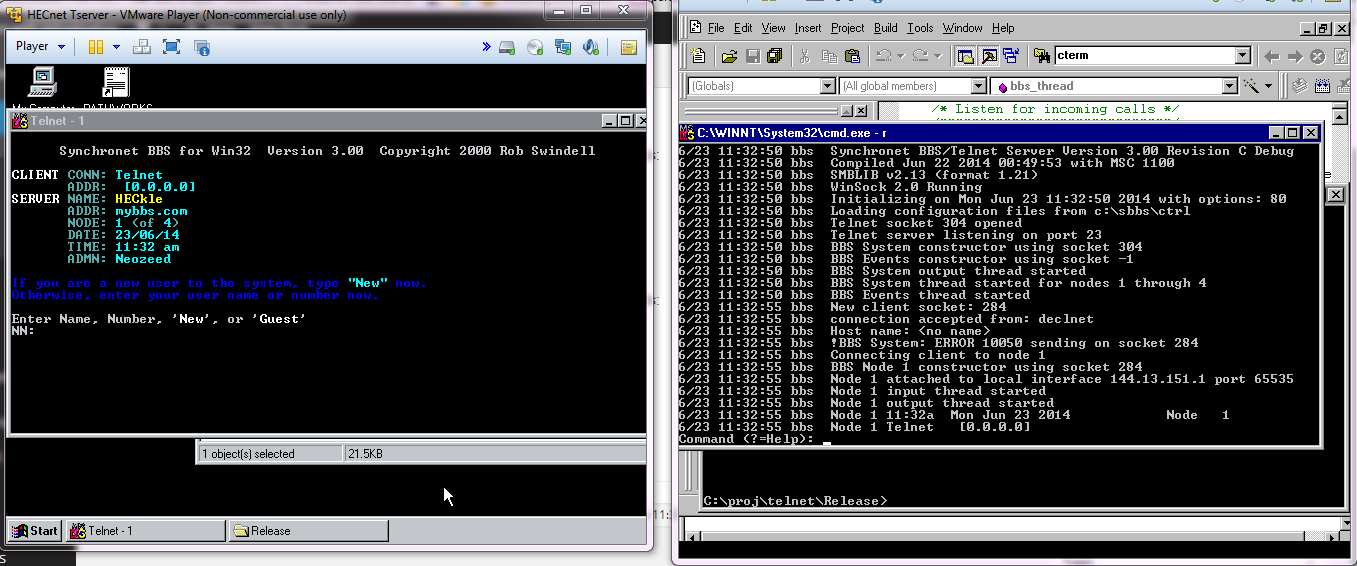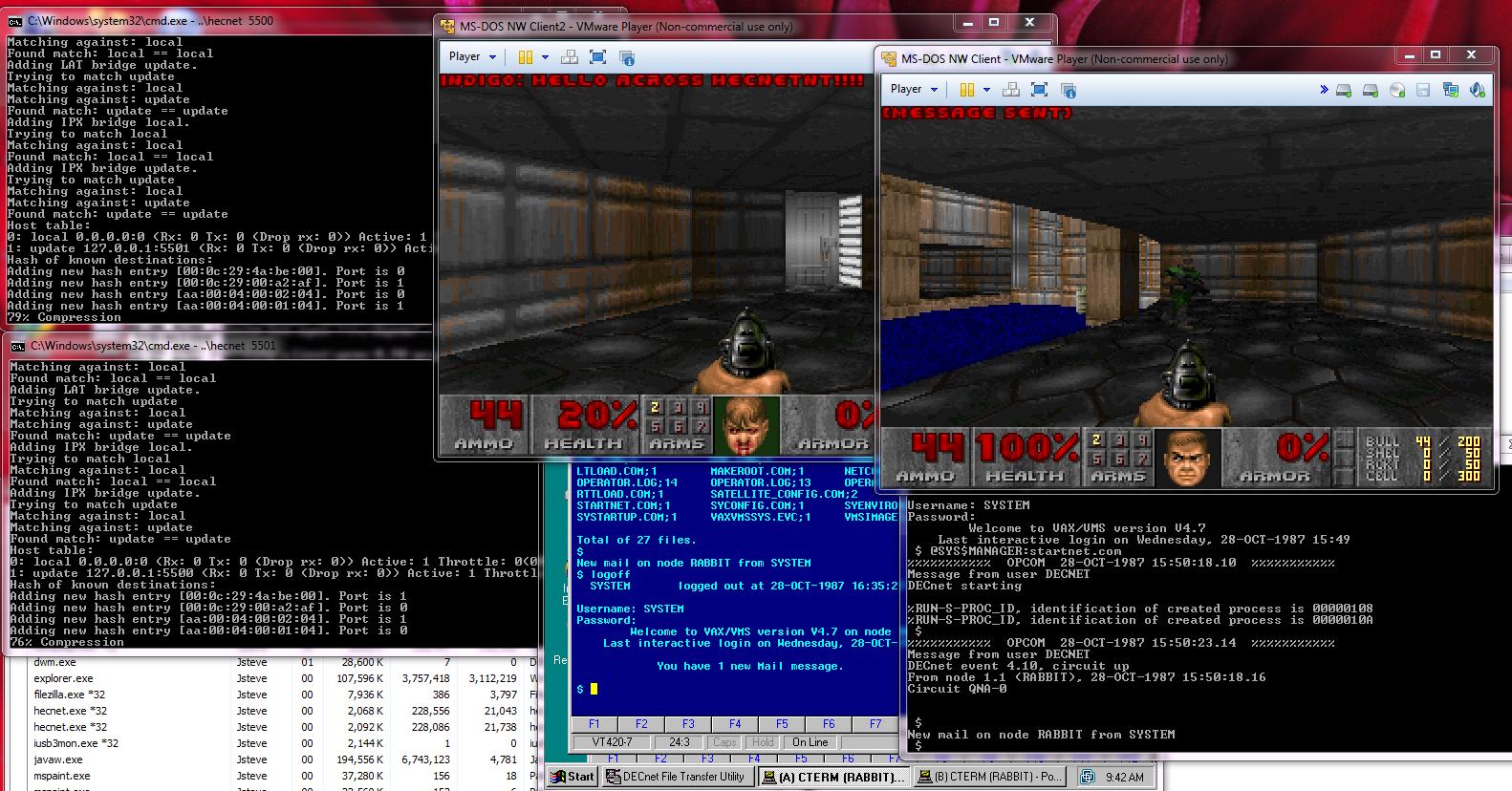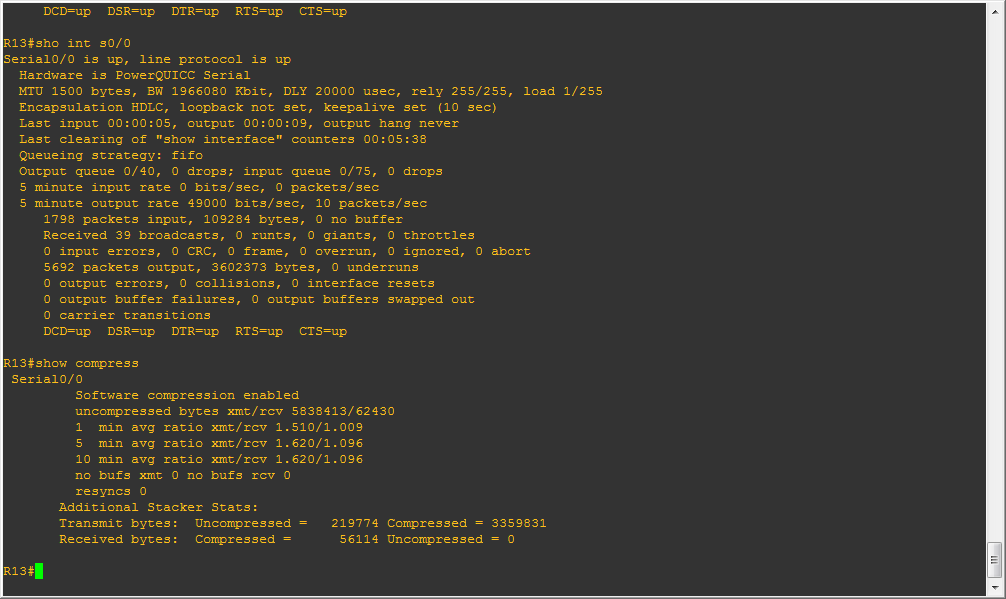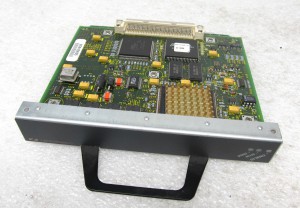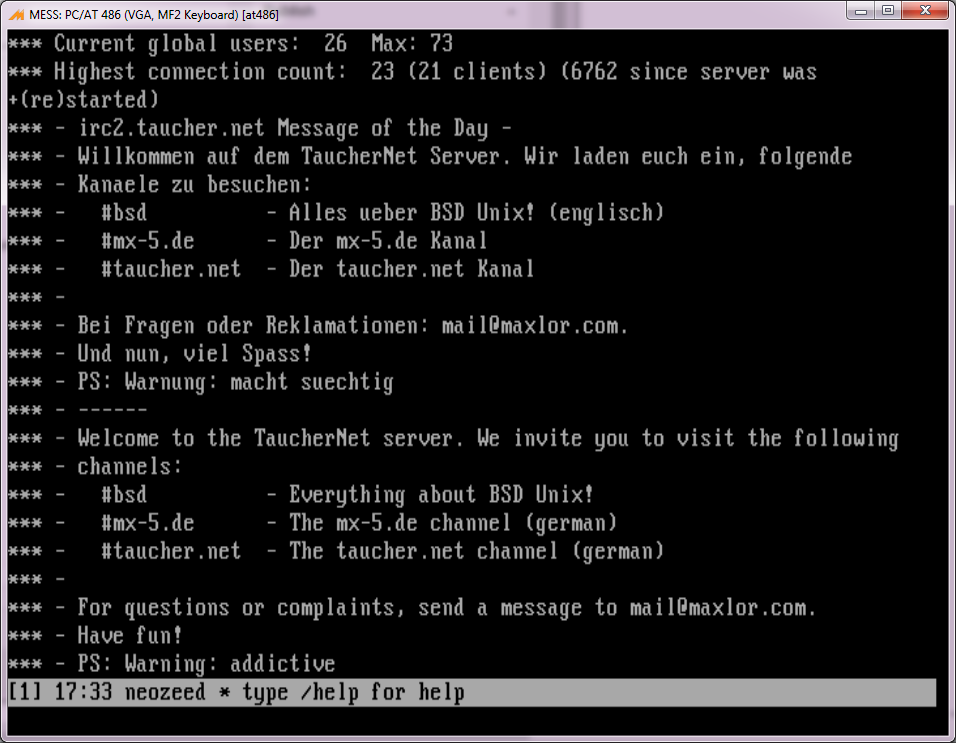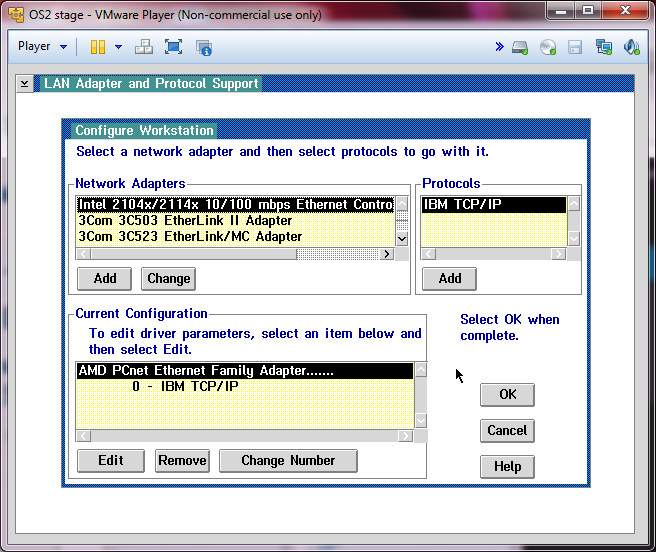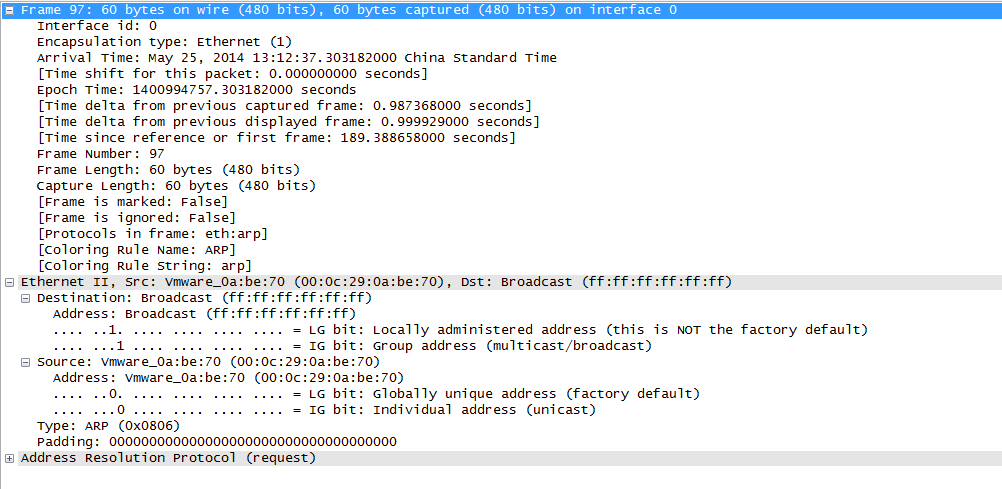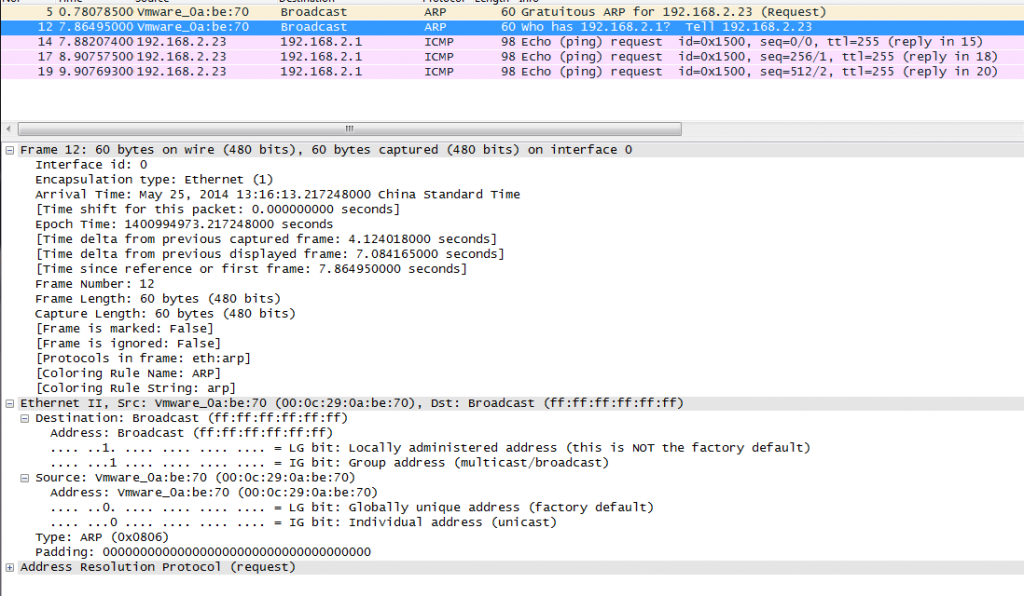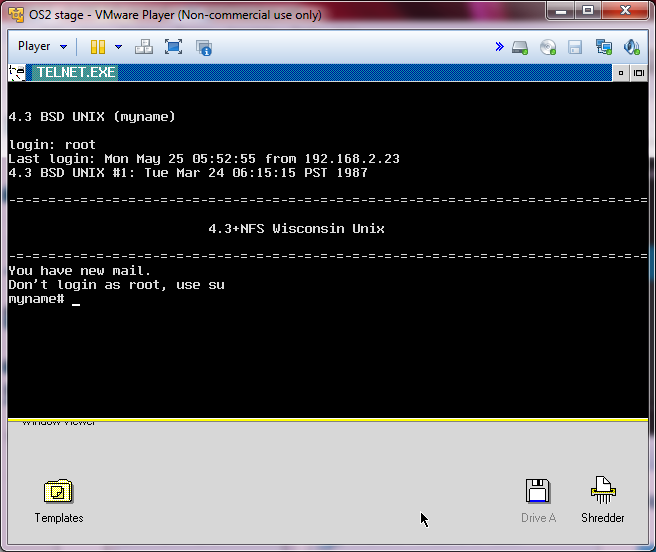Years ago, I was given an image of VMS 4.7. Â I only tested it for idle capabilities, and that is as far as I got with it. Â I never used it for anything else.
But today I needed to verify my Win32 Hecnet project works, so I needed to generate some legit DECNet traffic. Â Luckily I still have the VMS image, and in the prevailing years I managed to get a copy of PathWorks for Windows NT (And one for MS-DOS as well!).
So googling around, I found blinkenbone who mentions the command needed to setup some DECNet love.  Now the one thing that is strange about DECNet is that the MAC address needs to be changed to the DECNet area & node id.  Thankfully there is an online calculator, powerdog.  Since I’m just testing, I’ll put my VAX in area 1, node 1, that means the VAX MAC needs to be set to:
AA-00-04-00-01-04
So in SIMH, I just use the line:
set xq mac=AA-00-04-00-01-04
Cool. Â Now I use ansicon, in the hopes it’ll make the console better, and fire up VMS.
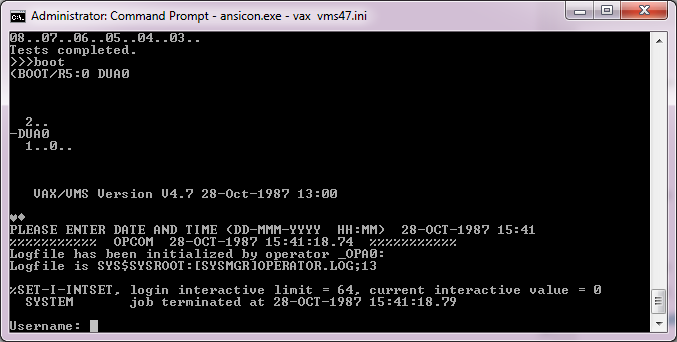
VMS 4.7 booted
And then login as system/manager
Now I can setup decnet very simply like this:
Username: SYSTEM
Password:
Welcome to VAX/VMS version V4.7
Last interactive login on Saturday, 20-SEP-2008 17:32
$ @sys$manager:netconfig
DECnet-VAX network configuration procedure
This procedure will help you define the parameters needed to get DECnet
running on this machine. You will be shown the changes before they are
executed, in case you wish to perform them manually.
What do you want your DECnet node name to be? : rabbit
What do you want your DECnet address to be? : 1.1
Do you want to operate as a router? [NO (nonrouting)]:
Do you want a default DECnet account? [YES]:
Here are the commands necessary to setup your system.
————————————————————————–
$ RUN SYS$SYSTEM:NCP
PURGE KNOWN OBJECTS ALL
PURGE MODULE CONFIGURATOR KNOWN CIRCUITS ALL
$ DEFINE/USER SYS$OUTPUT NL:
$ DEFINE/USER SYS$ERROR NL:
$ RUN SYS$SYSTEM:NCP ! Remove existing entry, if any
PURGE NODE 1.1 ALL
PURGE NODE RABBIT ALL
$ RUN SYS$SYSTEM:NCP
DEFINE EXECUTOR ADDRESS 1.1 STATE ON
DEFINE EXECUTOR NAME RABBIT
DEFINE EXECUTOR MAXIMUM ADDRESS 1023
DEFINE EXECUTOR TYPE NONROUTING IV
DEFINE EXECUTOR NONPRIVILEGED USER DECNET
DEFINE EXECUTOR NONPRIVILEGED PASSWORD DECNET
$ DEFINE/USER_MODE SYSUAF SYS$SYSTEM:SYSUAF.DAT
$ RUN SYS$SYSTEM:AUTHORIZE
ADD DECNET /OWNER=”DECNET DEFAULT” –
/PASSWORD=DECNET –
/UIC=[376,376] /ACCOUNT=DECNET –
/DEVICE=SYS$SPECIFIC: /DIRECTORY=[DECNET] –
/PRIVILEGE=(TMPMBX,NETMBX) –
/DEFPRIVILEGE=(TMPMBX,NETMBX) –
Press RETURN to continue
/FLAGS=(CAPTIVE) /LGICMD=NL: –
/NOBATCH /NOINTERACTIVE
$ CREATE/DIRECTORY SYS$SPECIFIC:[DECNET] /OWNER=[376,376]
$ RUN SYS$SYSTEM:NCP
DEFINE LINE QNA-0 STATE ON
DEFINE CIRCUIT QNA-0 STATE ON COST 4
DEFINE LOGGING MONITOR STATE ON
DEFINE LOGGING MONITOR EVENTS 0.0-9
DEFINE LOGGING MONITOR EVENTS 2.0-1
DEFINE LOGGING MONITOR EVENTS 4.2-13,15-16,18-19
DEFINE LOGGING MONITOR EVENTS 5.0-18
DEFINE LOGGING MONITOR EVENTS 128.0-4
————————————————————————–
Do you want to go ahead and do it? [YES]:
%UAF-I-ADDMSG, user record successfully added
%UAF-I-RDBADDMSGU, identifier DECNET value: [000376,000376] added to RIGHTSLIST.
DAT
%UAF-I-DONEMSG, system authorization file modified
%UAF-I-RDBDONEMSG, rights database modified
%NCP-I-NMLRSP, listener response – Success
Logging sink type = monitor
%NML-I-RECADDED, Database entry added
The changes have been made.
If you have not already installed the DECnet-VAX license, then do so now.
After the license has been installed, you should invoke the procedure
SYS$MANAGER:STARTNET.COM to startup DECnet-VAX with these changes.
(If the license is already installed) Do you want DECnet started? [YES]:
%%%%%%%%%%% OPCOM 28-OCT-1987 15:42:37.64 %%%%%%%%%%%
Message from user DECNET
DECnet starting
%RUN-S-PROC_ID, identification of created process is 00000109
%RUN-S-PROC_ID, identification of created process is 0000010B
$
%%%%%%%%%%% OPCOM 28-OCT-1987 15:42:42.67 %%%%%%%%%%%
Message from user DECNET
DECnet event 4.10, circuit up
From node 1.1 (RABBIT), 28-OCT-1987 15:42:37.69
Circuit QNA-0
It basically set itself up.
And on the Windows NT side, I simply set itself up as node 2 in area 1.
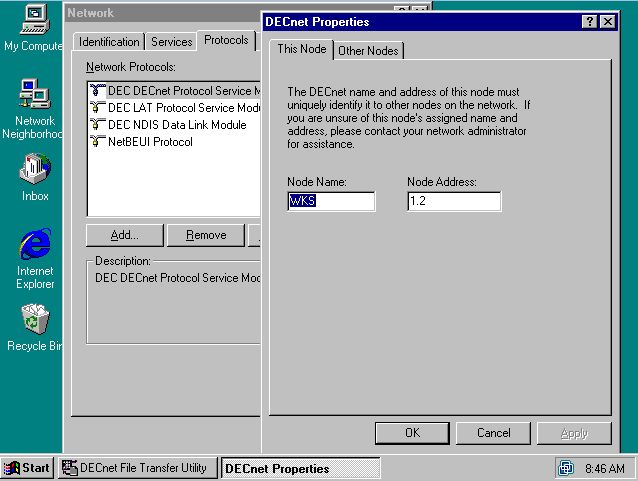
Windows NT + Pathworks
And now I can use CTERM to connect to the VAX.
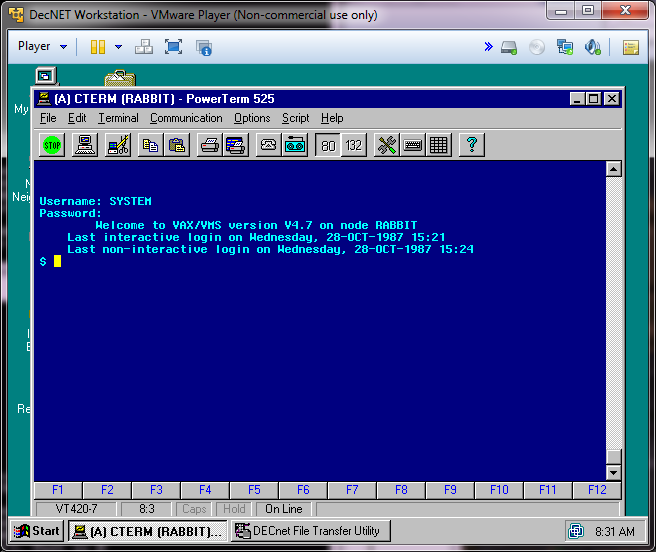
CTERM
Nice!. Â And it even works through my port of HECNet.
On reboots you have to manually start the network. Â I don’t have EDT, or I don’t know where to find it (remember the gold key? ugh).
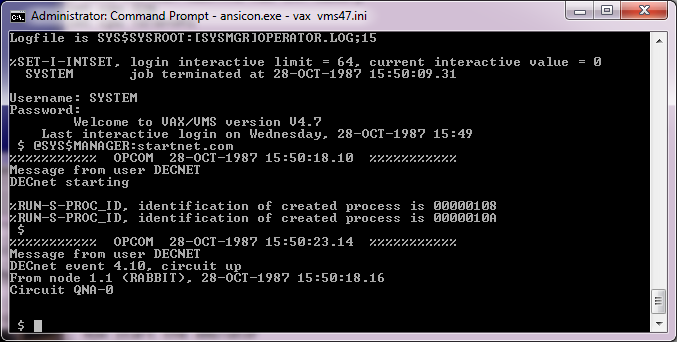
Manually starting the network
But it’s a simple command:
@SYS$MANAGER:startnet.com
And you are good to go!
Likewise shutting down is accomplished with this:
@SYS$SYSTEM:SHUTDOWN.COM
And that’s about all I know about VMS. Â But it’s good to see that configuring this was pain free!

